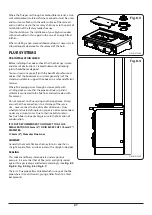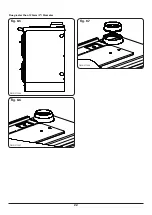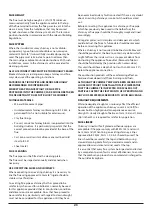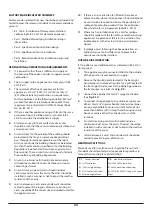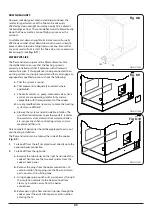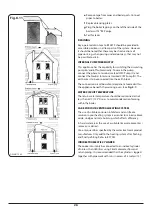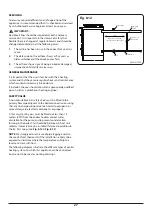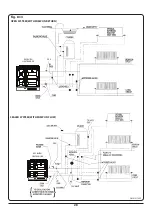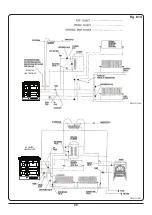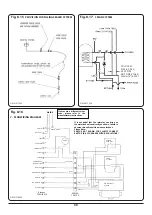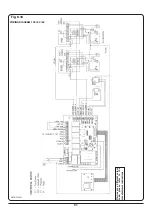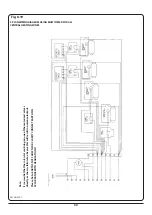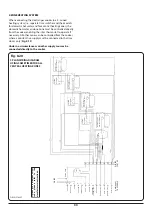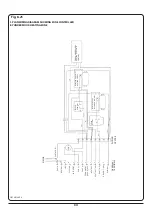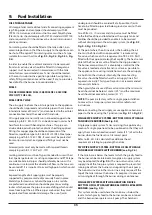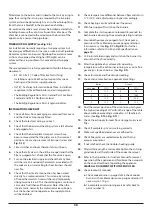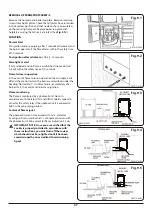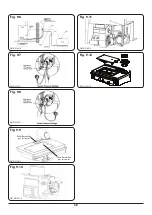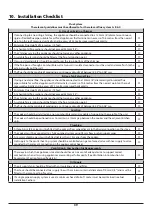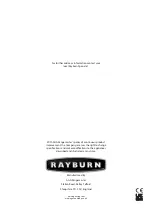
35
OIL STORAGE TANKS
Oil storage tanks made of steel and all connecting equipment
(eg: filling pipes and vent pipes) should comply with B.S.
799 Part 5. Galvanised steel must not be used. Polyethylene
(Plastic) tanks should comply with OFTEC standard OFS T100
and or equivalent. Oil should never be stored in translucent
plastic containers.
An isolating valve should be fitted at the tank outlet, in an
accessible position so that the oil supply to the appliance can
be shut off if required. This isolating valve must be of a type
suitable for use with oil. (See
&
In order to enable the sediment and water to be removed
from tanks a drain valve should be fitted. Oil storage tank
support must be carried out in accordance with the tank
manufactures recommendations. Tanks should be located
in the most un-obstructive position possible having taken
safety, filling, maintenance and the need, if any, to provide a
head of oil for the burner into consideration.
FUELS
THE RECOMMENDED FUEL IS KEROSENE 28 SECOND
VISCOSITY FUEL OIL.
FUEL SUPPLY LINE
The oil supply line from the oil storage tank to the appliance
should be of an approved and suitable pipe with a minimum
internal diameter of 9mm (3/8”) and connected to the oil inlet
connection located at the cooker left hand side.
Oil supply pipes are normally run in annealed copper tube
complying to B.S. E.N. 1057. It can be obtained in coil or half
hard form for use with bending machines. This pipe can
also be obtained with protective plastic sheathing applied.
Fittings for copper pipe should be compression of the
flared manipulative type to B.S. 864: Part 2 1983. Steel pipes
complying with B.S. 1387: 1985, if used, must be protected
from corrosion. Galvanised pipe and fittings must not be
used.
Screwed joints must only be made with tapered threads
complying with B.S. 1740: Part 1: 1971.
Jointing materials must be of types intended for use with oil
fuel. Special petroleum – resisting compounds and PTFE tape
are suitable. External pipes should preferably be run with a
continuous rise towards the direction of flow, so that one can
be vented off. It is important to avoid high points which could
cause air locks.
Exposed lengths of oil supply pipe must be properly
supported by purpose made clips securely fixed in place.
Metal clips formed so as to hold the pipe on to a saddle
are preferred. Consideration should be given to avoiding
routes which expose the pipe to severe chilling which could
cause freezing of the oil. Where pipes are buried, they must
be protected from accidental damage. The use of joints
underground should be avoided if at all possible. If joints
have to be fitted in pipes laid below ground, access to them
must be provided.
An oil filter (5 - 10 micron) and stop valve must be fitted
to the fuel feed line and located near the supply tank and
facilities should be provided to enable it to be serviced
without draining down the oil supply system. (See
At the point where the oil line enters the building, the oil
line must be fitted with an approved 65ºC remote acting
fire valve, which meets the requirements of B.S. 5410: Part 1,
fitted with the appropriate length of capillary. The heat sensor
phial of the fire valve must be fitted to the clip provided in
the burner compartment. It is absolutely essential that the
fire valve is located externally and is as close as possible to
the appliance. For existing installations where the oil supply
are built into the structure internally, the remote acting
fire valve should be fitted where the oil supply line is first
exposed internally. This type of layout is not recommended
for new installations.
When gravity feed is used (the most common) the minimum
head should not be below 1 meter (3’3”) and the maximum
head should not exceed 6.5 meters (21’ 3”).
NOTE
: The pump is factory set for a single pipe installation
to convert to a two pipe system consult manufacturer’s
instructions.
Before connecting the oil supply, secure appliance burner oil
pipes to the base using the T junction (see
&
).
SINGLE PIPE SUPPLY SYSTEM: BOTTOM OF OIL STORAGE
TANK ABOVE BURNER (See
)
Single pipe supply system: Tanks servicing this appliance by
means of a single pipe need to be positioned so that they will
apply the minimum head required 1 meter (3’ 3”) of oil to the
burner when the fuel level is at its lowest point.
Refer to B.S. 5410 to calculate the additional head
requirement relating to pipe length and size.
TWO PIPE SUPPLY SYSTEM: BOTTOM OF OIL STORAGE
TANK BELOW OR LEVEL WITH BURNER (see
If the tank base is below the level at which the gravity feed to
the burner can be maintained, a two pipe oil supply system
may be adopted. (See
). The non-return valve in the
supply line of the two pipe system is required to prevent oil
running back from the burner and unpriming the oil pump.
The non-return valve in the return line is only required if the
top of the tank is above the burner. Its purpose is to prevent
oil running back through the burner during maintenance.
SINGLE PIPE SYSTEM: WITH DE-AERATION DEVICE
BOTTOM OF OIL STORAGE TANK BELOW OR LEVEL WITH
):
This system can be used where the tank base is below the
level at which gravity feed to the burner can be maintained
and the burner incorporates an oil pump. The chamber is
9. Fuel Installation

